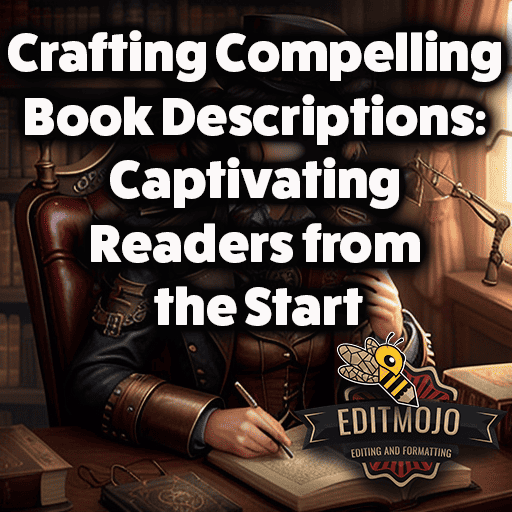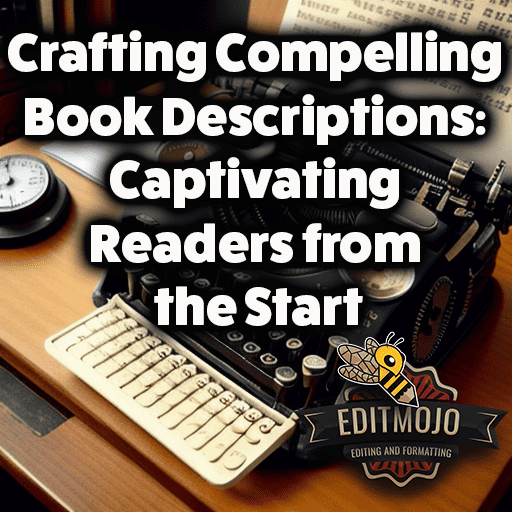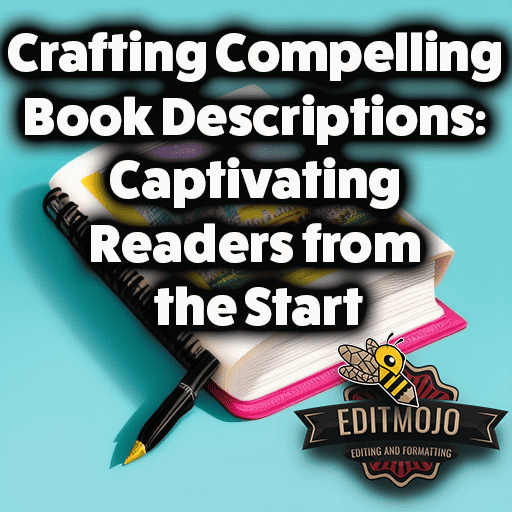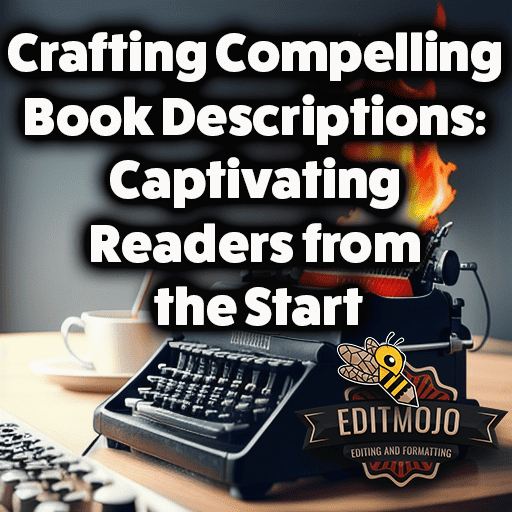Crafting Compelling Book Descriptions: Captivating Readers from the Start
Crafting Compelling Book Descriptions: Captivating Readers from the Start. As an author, you’ve spent countless hours crafting your story, immersing yourself in the worlds of your characters, pouring your heart and soul onto every page. But what about your book’s description? Is it as carefully crafted as the rest of your work?
I recall the day when I first realized the importance of a compelling book description. I was browsing through an online bookstore, casually clicking on book titles that caught my interest. But what made me finally reach for my wallet wasn’t the title or the book cover, it was the book description of a relatively obscure novel. It drew me in, promised an adventure I simply couldn’t resist. That was the day I truly understood that a book description could be as captivating as the story itself.
Just as Maya Angelou once said, “Words mean more than what is set down on paper. It is the lens through which we view the world.” This post aims to turn your book description into a clear, compelling lens for potential readers.
Key Takeaways
| Topic | Key Points |
|---|---|
| Importance of Book Descriptions | Book descriptions play a crucial role in book marketing, impacting sales, reader engagement, and reviews. |
| Understanding Your Reader | Knowing your target audience, their preferences, and motivations is key to crafting a compelling book description. |
| Common Mistakes and Misconceptions | Avoid common pitfalls such as revealing too much plot or writing overly lengthy descriptions. Strive for balance between intrigue and information. |
| Secrets to Crafting Compelling Descriptions | Effective descriptions introduce the protagonist, setting, and conflict while maintaining an air of intrigue. |
| Fine-Tuning Your Description | The process of perfecting a book description involves iterative drafting, seeking feedback, and refining until it resonates with your target audience. |

The Importance of Crafting Compelling Book Descriptions
It’s easy to underestimate the power of a book description. However, in the realm of book marketing, it is one of the most crucial tools at an author’s disposal. It’s your first (and possibly only) chance to draw in a potential reader.
Consider the case of The Martian by Andy Weir. The description immediately introduces readers to the protagonist’s predicament, gripping them with a visceral sense of what’s at stake. It’s no surprise that this compelling description was instrumental in the book’s eventual success.
So, what should you expect when you dedicate time and creativity to improving your book description? Expect to see a significant increase in sales and reader engagement, and a flood of positive reviews.
Understanding Your Reader: The Key to Compelling Descriptions
Before you can craft a compelling description, you must understand your target audience. Who are they? What intrigues them? Which phrases would catch their eye?
In an interview, Dr. Susan Weinschenk, a renowned psychologist specializing in consumer behavior, stressed the importance of understanding your target readers’ motivations. She explained that authors should strive to understand what their readers seek in a book, and then incorporate those elements into the book description.
By understanding your reader, not only will you improve your book description, but you will also hone your overall writing and marketing strategy.

Common Mistakes and Misconceptions in Writing Book Descriptions
As we navigate the journey of writing a book description, it’s crucial to learn from our mistakes. I recall my first blunder in this realm, a lengthy, detailed description that divulged too much of the plot. It failed to generate the curiosity required to engage potential readers.
There’s a common misconception that a longer book description is a better one. However, the art of crafting a compelling description is about balancing intrigue and information, not overwhelming the reader with plot details. The key is to pique readers’ interest without revealing too much.
This principle was strikingly evident in the case of Gone Girl by Gillian Flynn. The description is relatively short, yet it masterfully conveys the suspense and mystery that awaits the reader. After Flynn revised her description to be more succinct and mysterious, the book’s sales skyrocketed.
Secrets to Crafting Captivating Book Descriptions
The secret to writing an
enticing book description lies in its ability to captivate the reader, making them feel as if they’ve discovered a treasure. According to Bryan Cohen, a best-selling author and book marketing expert, an effective book description should introduce the protagonist, the setting, and the conflict, all while maintaining an air of intrigue.
Here is a simple step-by-step guide:
- Introduce your protagonist: Provide a brief introduction of your main character that helps readers form an emotional connection.
- Set the stage: Describe the world your character inhabits without revealing too much detail.
- Present the conflict: Introduce the challenge or struggle your protagonist will face.
- Maintain an air of intrigue: Tease the reader with the promise of a riveting journey without spoiling any major plot points.
As J.K. Rowling once said, “Words are, in my not-so-humble opinion, our most inexhaustible source of magic.” Crafting a compelling book description is about harnessing that magic to captivate your readers from the start.

Do’s and Don’ts of Writing Book Descriptions
In the realm of book descriptions, some guidelines can significantly improve your craft. Here are some essential do’s and don’ts to remember:
- Do create a sense of intrigue.
- Don’t reveal too much of the plot.
- Do highlight the protagonist’s conflict.
- Don’t use generic descriptions.
- Do target your intended audience.
Following these guidelines will ensure your book description has the necessary elements to captivate your target audience. The Da Vinci Code by Dan Brown is a prime example. The book description is a masterclass in creating intrigue, highlighting conflict, and targeting its intended audience, which significantly contributed to its astounding global success.
Fine-Tuning Your Book Description
The process of perfecting a book description often involves revising and refining until it resonates with your target audience. Jane Friedman, a seasoned editor and publishing expert, advises authors to “write multiple versions of their book description, seek feedback, and constantly refine the wording until it hits the mark.”
I vividly recall the numerous drafts and revisions I made to my first book description. Though at times it felt tedious, the impact on my reader engagement was well worth the effort. Remember, as the old saying goes, “The only kind of writing is rewriting.”
Conclusion
Crafting a compelling book description is an art. It requires a blend of understanding your audience, maintaining intrigue, presenting the conflict, and fine-tuning until it captures the essence of your book. As Emily Dickinson beautifully expressed, “A word is dead when it is said, some say. I say it just begins to live that day.”
Now, with these tools and insights at your disposal, the task of crafting your book description should no longer feel daunting but rather exciting. It’s time for you to breathe life into your words and captivate your readers from the start. So, go on, unleash the power of your book description and watch your story take flight!
Top Five Questions and Answers
Q1: Why is a compelling book description important?
A1: A compelling book description attracts potential readers, increasing book sales and reader engagement. It’s often the first (and possibly only) chance to draw in a reader, making it an essential part of book marketing.
Q2: What are common mistakes in writing book descriptions?
A2: Common mistakes include revealing too much of the plot, writing overly lengthy descriptions, and failing to create intrigue. Authors should aim to pique readers’ interest without giving away crucial plot points.
Q3: How can I craft a compelling book description?
A3: Start by introducing the protagonist, setting, and conflict. Make sure to maintain an air of intrigue. Avoid revealing too much detail and ensure your description resonates with your target audience.
Q4: What should I remember while writing a book description?
A4: Remember to create a sense of intrigue, highlight the protagonist’s conflict, target your intended audience, and avoid using generic descriptions. Also, don’t forget that the process involves iterative revisions and feedback.
Q5: How does understanding the reader help in crafting a compelling book description?
A5: Understanding your target audience enables you to tailor your book description to their preferences and motivations. This increases the likelihood of the description resonating with them, enhancing reader engagement.
